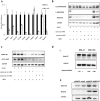Cellular response to persistent foot-and-mouth disease virus infection is linked to specific types of alterations in the host cell transcriptome
- PMID: 29568077
- PMCID: PMC5864922
- DOI: 10.1038/s41598-018-23478-0
Cellular response to persistent foot-and-mouth disease virus infection is linked to specific types of alterations in the host cell transcriptome
Abstract
Food-and-mouth disease virus (FMDV) is a highly contagious virus that seriously threatens the development of animal husbandry. Although persistent FMDV infection can dramatically worsen the situation, the mechanisms involved in persistent FMDV infection remain unclear. In the present study, we identified the presence of evolved cells in the persistently FMDV-infected cell line. These cells exhibited resistance to the parent FMDV and re-established persistent infection when infected with FMDV-Op (virus supernatant of persistent infection cell lines), emphasizing the decisive role of evolved host cells in the establishment of persistent FMDV infection. Using RNA-seq, we identified the gene expression profiles of these evolved host cells. In total, 4,686 genes were differentially expressed in evolved cells compared with normal cells, with these genes being involved in metabolic processes, cell cycle, and cellular protein catabolic processes. In addition, 1,229 alternative splicing events, especially skipped exon events, were induced in evolved cells. Moreover, evolved cells exhibited a stronger immune defensive response and weaker MAPK signal response than normal cells. This comprehensive transcriptome analysis of evolved host cells lays the foundation for further investigations of the molecular mechanisms of persistent FMDV infection and screening for genes resistant to FMDV infection.
Conflict of interest statement
The authors declare no competing interests.
Figures






Similar articles
-
Comparative Transcriptome Analysis Reveals Different Host Cell Responses to Acute and Persistent Foot-and-Mouth Disease Virus Infection.Virol Sin. 2020 Feb;35(1):52-63. doi: 10.1007/s12250-019-00155-8. Epub 2019 Sep 11. Virol Sin. 2020. PMID: 31512107 Free PMC article.
-
Next-generation sequencing sheds light on the interaction between virus and cell during foot-and-mouth disease virus persistent infection.Vet Microbiol. 2021 Dec;263:109247. doi: 10.1016/j.vetmic.2021.109247. Epub 2021 Sep 30. Vet Microbiol. 2021. PMID: 34649012
-
Transcriptomic Analysis of Persistent Infection with Foot-and-Mouth Disease Virus in Cattle Suggests Impairment of Apoptosis and Cell-Mediated Immunity in the Nasopharynx.PLoS One. 2016 Sep 19;11(9):e0162750. doi: 10.1371/journal.pone.0162750. eCollection 2016. PLoS One. 2016. PMID: 27643611 Free PMC article.
-
Virus-Host Interactions in Foot-and-Mouth Disease Virus Infection.Front Immunol. 2021 Feb 26;12:571509. doi: 10.3389/fimmu.2021.571509. eCollection 2021. Front Immunol. 2021. PMID: 33717061 Free PMC article. Review.
-
The Pathogenesis of Foot-and-Mouth Disease Virus Infection: How the Virus Escapes from Immune Recognition and Elimination.Arch Immunol Ther Exp (Warsz). 2024 Jun 24;72(1). doi: 10.2478/aite-2024-0013. eCollection 2024 Jan 1. Arch Immunol Ther Exp (Warsz). 2024. PMID: 38910298 Review.
Cited by
-
Single-Cell Sequencing Yields Insights in the Evolution of Foot-and-Mouth Disease Virus Persistent Infection.Front Cell Infect Microbiol. 2022 Jul 8;12:940906. doi: 10.3389/fcimb.2022.940906. eCollection 2022. Front Cell Infect Microbiol. 2022. PMID: 35873170 Free PMC article.
-
Evaluation of Potency and Duration of Immunity Elicited by a Multivalent FMD Vaccine for Use in South Africa.Front Vet Sci. 2021 Dec 15;8:750223. doi: 10.3389/fvets.2021.750223. eCollection 2021. Front Vet Sci. 2021. PMID: 34977205 Free PMC article.
-
A review of foot-and-mouth disease in Ethiopia: epidemiological aspects, economic implications, and control strategies.Virol J. 2023 Dec 15;20(1):299. doi: 10.1186/s12985-023-02263-0. Virol J. 2023. PMID: 38102688 Free PMC article. Review.
-
Comparative Transcriptome Analysis Reveals Different Host Cell Responses to Acute and Persistent Foot-and-Mouth Disease Virus Infection.Virol Sin. 2020 Feb;35(1):52-63. doi: 10.1007/s12250-019-00155-8. Epub 2019 Sep 11. Virol Sin. 2020. PMID: 31512107 Free PMC article.
-
The Host Protein CAD Regulates the Replication of FMDV through the Function of Pyrimidines' De Novo Synthesis.J Virol. 2023 May 31;97(5):e0036923. doi: 10.1128/jvi.00369-23. Epub 2023 May 10. J Virol. 2023. PMID: 37162335 Free PMC article.
References
Publication types
MeSH terms
LinkOut - more resources
Full Text Sources
Other Literature Sources
Molecular Biology Databases
Miscellaneous

